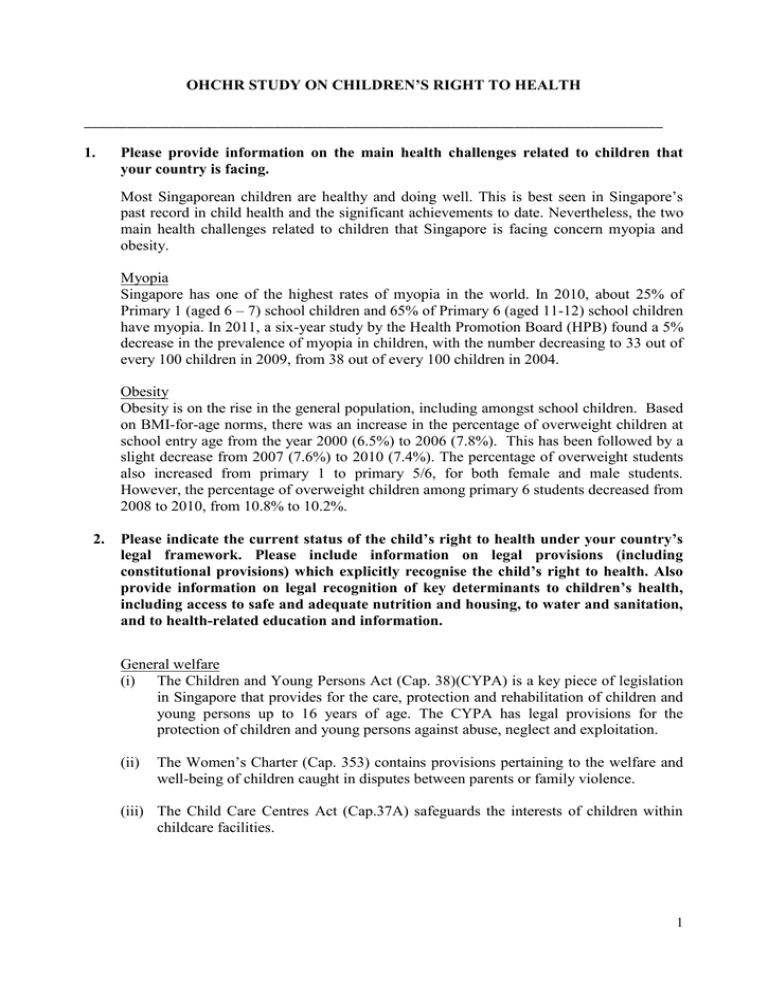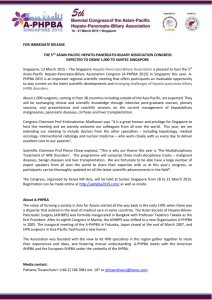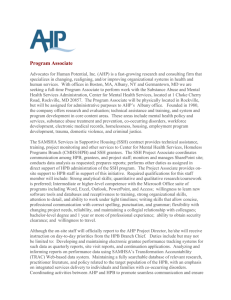OHCHR STUDY ON CHILDREN’S RIGHT TO HEALTH 1.
advertisement

OHCHR STUDY ON CHILDREN’S RIGHT TO HEALTH __________________________________________________________________________________ 1. Please provide information on the main health challenges related to children that your country is facing. Most Singaporean children are healthy and doing well. This is best seen in Singapore’s past record in child health and the significant achievements to date. Nevertheless, the two main health challenges related to children that Singapore is facing concern myopia and obesity. Myopia Singapore has one of the highest rates of myopia in the world. In 2010, about 25% of Primary 1 (aged 6 – 7) school children and 65% of Primary 6 (aged 11-12) school children have myopia. In 2011, a six-year study by the Health Promotion Board (HPB) found a 5% decrease in the prevalence of myopia in children, with the number decreasing to 33 out of every 100 children in 2009, from 38 out of every 100 children in 2004. Obesity Obesity is on the rise in the general population, including amongst school children. Based on BMI-for-age norms, there was an increase in the percentage of overweight children at school entry age from the year 2000 (6.5%) to 2006 (7.8%). This has been followed by a slight decrease from 2007 (7.6%) to 2010 (7.4%). The percentage of overweight students also increased from primary 1 to primary 5/6, for both female and male students. However, the percentage of overweight children among primary 6 students decreased from 2008 to 2010, from 10.8% to 10.2%. 2. Please indicate the current status of the child’s right to health under your country’s legal framework. Please include information on legal provisions (including constitutional provisions) which explicitly recognise the child’s right to health. Also provide information on legal recognition of key determinants to children’s health, including access to safe and adequate nutrition and housing, to water and sanitation, and to health-related education and information. General welfare (i) The Children and Young Persons Act (Cap. 38)(CYPA) is a key piece of legislation in Singapore that provides for the care, protection and rehabilitation of children and young persons up to 16 years of age. The CYPA has legal provisions for the protection of children and young persons against abuse, neglect and exploitation. (ii) The Women’s Charter (Cap. 353) contains provisions pertaining to the welfare and well-being of children caught in disputes between parents or family violence. (iii) The Child Care Centres Act (Cap.37A) safeguards the interests of children within childcare facilities. 1 Adoption and custody (iv) The Adoption of Children Act (Cap.4) provides that before an adoption order is made, the court, amongst other things, must be satisfied that the order, if made, will be for the welfare of the infant. (v) The Guardianship of Infants Act (Cap. 122) provides that the court shall regard the welfare of the infant as the first and paramount consideration in any proceeding involving the custody or upbringing of an infant. Employment (vi) The Employment Act (Cap. 91) generally prohibits children below 13 years old from being employed, except in very limited circumstances, while those between the ages of 13 and 16 years may be employed subject to employers’ compliance with the safeguards in the Act. Highly hazardous occupations can only employ adults aged 18 years and above. Compulsory vaccination (vii) The Infectious Diseases Act (Cap. 137) requires the parent or guardian of every child to ensure that the child is vaccinated against diphtheria and measles within prescribed timeframes. Control of use of tobacco products (viii) The Tobacco (Control of Advertisements and Sale) Act (Cap. 309) prohibits the sale or supply of tobacco products to persons below 18 years. Persons below 18 years of age are also prohibited from using tobacco products in public places or buying or having in his possession any tobacco product. 3. Please provide information on national policies, strategies and plans of action for addressing the priority concerns and challenges identified in question 1. Please include information as to whether the child’s right to health, including the right to health care, is explicitly referred to in existing policies, strategies and plans of action. Child Health As provided for under the Health Promotion Board Act (Cap. 11), one of the objectives of HPB is to provide healthcare services (including medical, dental, health-screening and immunisation services) to all school children. HPB is the key agency in the provision of programmes, services and activities for children and the youth. It aims to establish strong foundations of health and well-being for all children from the pre-natal stage of their lives and through their childhood years. Parents, their young and relevant stakeholders are provided the necessary knowledge, skills and services for a healthy head start to a brighter future. The key strategies adopted include: (i) Promoting positive health from birth and through the school going age group through immunisation, health and development screening for priority medical conditions; 2 (ii) (iii) (iv) (v) (vi) (vii) Promoting the concept of health through schools and encouraging schools to establish comprehensive school health promotion programmes; Organising school-based and community-based activities to increase awareness of key health messages and skills among parents, school students and the youth at community settings; Engaging and supporting peer-led youth health initiatives; Collaborating with organisations to promote health to children and the youth; Building capacity of schools and community through training programmes for educators and youth facilitators and parent education programmes; and Developing and providing educational resources to support health promotion programmes run in schools and community settings for parents, children and the youth. Myopia Vision screening is part of the School Health Screening (SHS) programme. HPB closely monitors the prevalence of myopia amongst school children through vision screening under the SHS programme. A dedicated National Myopia Prevention Programme (NMPP) Steering Committee comprising paediatric ophthalmologists and representatives from collaborating ministries was formed in July 2001 to advise and provide guidance on the NMPP’s direction. Vision screening is provided to pre-school children and schoolchildren at primary and secondary school levels annually as part of the SHS Programme. Additionally, as part of the NMPP, myopia prevention activities have been organized to reach out to the public and schools to educate the children, their parents and teachers on good eye care habits and practices. Singapore is a world leader in myopia research. Over the past decade, the National Medical Research Council (NMRC) and Biomedical Research Council (BMRC) have given $7.8 million and $4 million to researchers to study myopia and eye epidemiology respectively. Obesity Height and weight BMI is monitored annually for primary and secondary school students. In 2010, Singapore switched from weight-for-height charts to new BMI-for-age charts to monitor obesity in children. i) School Environment The Healthy Eating in Schools Programme (HESP) seeks to enhance the availability of healthier food and beverage choices in schools through an integrated programme involving teachers, canteen vendors and students. In 2011, HPB further enhanced the HESP by introducing well-balanced healthy set meals that include fruits and vegetables. The CHERISH (CHampioning Efforts Resulting in Improved School Health) Award is a joint effort by HPB and the Ministry of Education (MOE) to recognise schools that have done well in promoting health, including efforts to combat obesity. A similar CHERISH Junior award was also rolled out in 2010 to encourage and recognise pre-schools for their health promotion efforts. 3 To address the prevalence of obesity in certain segments of the student population, HPB has initiated discussions with the Institutes of Higher Learning (IHL), in particular the Polytechnics and Institutes of Technical Education (ITE), to gain deeper insights on obesity-related issues. In 2011, a Health Promoting Campus Framework was developed and promoted to IHLs. All ITEs and Polytechnics will participate in this Framework in 2012. In August 2012, HPB also launched the “Let’s Drink Water” campaign, which is intended to encourage children of school-going age to replace sugary drinks with water. In addition, under HPB’s CHERISH framework, primary schools, secondary schools, junior colleges and the centralised institutes are encouraged to make water coolers available around their premises. ii) Advertising to children The Ministry of Health (MOH), together with HPB, also reviewed parts of the Singapore Code of Advertising Practice related to food and beverage advertising targeted at children. HPB has been working with the Advertising Standards Authority of Singapore (ASAS), the food industry and the media to draw up a preliminary set of guidelines for the industry. iii) Physical activity Singapore has been instilling a culture of physical activity from young by increasing physical education (PE) in schools. In 2010, MOE increased PE time for all primary and secondary school levels. Schools will include an extra hour of PE each week, to be carried out in phases, in step with improving infrastructure in schools (i.e. indoor sports halls), implementing single-session primary schools and increasing the recruitment of PE teachers. Beginning 2014, MOE will roll out a new PE curriculum that aims to teach students to be able to play at least three sports by the time they graduate from secondary school. This is in line with the Singapore Sports Council’s Vision 2030 plans to help equip students for life-long sports participation. In 1992, MOE introduced the Trim and Fit (TAF) Programme in schools. The objectives were to improve the physical fitness of the student population and to reduce the percentage of overweight students. HPB supported the TAF Programme by providing educational materials and medical assessment of severely overweight or underweight students. In 2007, the Holistic Health Framework (HHF) replaced the TAF Programme. Aside from physical fitness, the HHF also takes into account students’ physical, mental, and social wellbeing. In 2011, HPB started a new “Healthy Origins and Firm Foundations Programme” as part of a broader strategy to move health promotion efforts upstream. This programme aims to empower parents-to-be, parents and other key stakeholders to foster wellness during pregnancy and to nurture healthy lifestyles during their children’s early years. 4. Please indicate what role schools have in promoting children’s right to health. Is health promotion included in the school curricula? 4 School health in Singapore is underpinned by the CHampioning Effors Resulting in Improved School Health (CHERISH) Framework. Modelled after WHO’s Health Promoting School Framework, CHERISH encompasses 6 strategic areas: (i) Healthy School Policies are documented and approved practices influencing the school’s actions in promoting the health and well-being of its students, staff, family and the wider community. (ii) Schools’ Physical Environment provides for a safe, secure, clean, sustainable, conducive and healthy environment for learning. (iii) School’s Social Environment fosters good relationships among and between students, staff, parents and the wider community. (iv) Community Links and partnerships are proactively established between schools, families, communities, organisations and other stakeholders. (v) Children and stakeholders are empowered with action competencies for healthy living through formal and informal curricula for students to gain age-related knowledge and life skills. (vi) School Health Care and Promotion Services are integrated and facilitated by the school for its students. The CHERISH framework spans from pre-schools to tertiary institutions and empowers schools and school leaders to play a significant role in the health of children. Preventive health care through immunisation and health and oral screening for children are provided by the School Health Service and the School Dental Service. The Student Health Centre provides clinic-based preventive and screening services for children who require further assessment following health screening in schools; for severely overweight and underweight students referred by MOE schools; and for children who missed immunisation in school. Health promotion programmes cover a range of health issues such as physical activity, healthy nutrition, mental wellness, smoking control, sexually transmitted infections and AIDS prevention, myopia prevention, oral health and childhood injury prevention. Avenues for professional help are made known in these programmes and materials. Through school counsellors and outreach programmes, youth at risk are identified and attention given to their needs. The Holistic Health Framework (HHF) aims to support schools with a structured framework to adopt a holistic health promotion approach (including physical, mental and social health). The HHF is underpinned by three guiding principles: (i) (ii) Total Well-Being Total well-being encompasses the physical, mental and social health of students and not just measures of weight and fitness. Inclusion Inclusion advocates that every student be given opportunities to access the knowledge, and develop the skills and attitudes to live healthily. 5 (iii) Quality Delivery Quality delivery involves building the capacity of teachers through professional development and engaging qualified and competent para-educators to teach holistic health effectively. Schools adopting the HHF are distinguished by the following key components: (i) Supportive School Culture and Organisation A supportive school culture and organisation is demonstrated by having a shared vision on health which culminates in an action plan for effective delivery and resource building. (ii) Comprehensive and Relevant Formal and Non-Formal Curricula A comprehensive and relevant formal and non-formal curricula is the main vehicle in the delivery of holistic health. (iii) Synergistic Collaborations and Partnerships Synergistic collaborations and partnerships with stakeholders supporting schools’ health promoting efforts through the sharing of expertise and resources. 5. Please provide examples of good practices undertaken by your Government to protect and promote children’s right to health, particularly in relation to children in especially difficult circumstances. In Singapore, the right to health is accorded to all children. National programmes have been instituted and are provided free of charge or at subsidised rates at the polyclinics and schools to all children. Screening and Immunisation The health screening programmes and immunisation carried out by the School Health Services are provided free to all school-going children in Singapore. Myopia In 2006, the Spectacles Voucher Fund, which is part of the NMPP, was established through a collaboration between HPB and lens manufacturer Essilor Singapore. This fund provides needy students who are diagnosed to have myopia, or found to be in need of new spectacles, with two vouchers which fully cover the cost of lenses and offset the cost of the frames. In early July 2012, a new pilot programme was launched in which roving optical shops set up temporary premises within five primary schools. Needy pupils receive free pairs of spectacles on the spot, instead of having to go to the shops. HPB also increased the sum of each voucher under the Spectacles Voucher Fund from $30 to $50. Obesity Singapore also has in place targeted programmes for the Institutes of Technical Education (ITEs), which admit a disproportionate number of students from lowerincome households. HPB and MOE instituted the following measures: (i) Introduction of new CHERISH or holistic health promotion framework for the ITE: HPB has introduced the CHERISH health promotion framework for the ITE in FY2011. 6 (ii) Deployment of Student Health Advisors (SHAs): Deployment of SHAs to the ITE to counsel and support overweight students to manage their weight through the adoption of healthy dietary practices and an active lifestyle. HPB has deployed 2 SHAs to ITE College East in January 2012. The SHA Programme will be rolled out to the other ITEs moving forward. (iii) ITEs will appoint full-time staff to assume the role of a Health Co-ordinator to address the health needs of the students on campus and work with HPB to implement health-related programmes. (iv) A health database which will capture essential information, such as weight, height and BMI at regular intervals, will be set up in the ITE. 6. Please indicate what the main barriers your Government finds when trying to implement children’s right to health. Nil Ministry of Community Development, Youth and Sports Ministry of Health Ministry of Education Singapore 10 Oct 2012 7


